Weekly Fishing Report: March 21
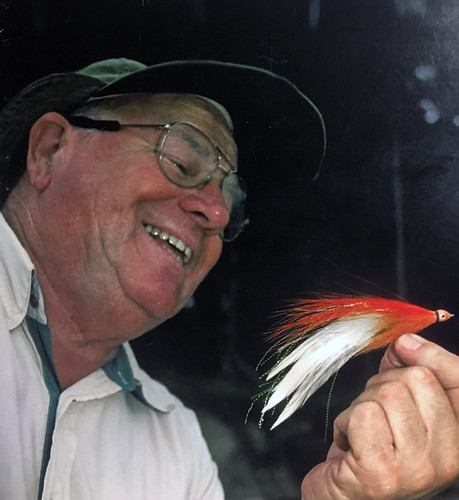
Photo by John Bildahl
Most everyone in the fishing community has heard the news by now: an iconic figure has passed to what he referred to his “spirit spring.”
The world will not be the same without Lefty Kreh, the Maryland hometown boy who shook up the fly-fishing world like nobody else ever has or possibly ever will. Lefty was one of kindest guys you could ever meet, with a heart of gold and a country-boy sense of humor that never left him throughout his life.
Last Sunday as I sat at Tampa airport waiting for a flight back to Maryland, I could not help but reflect on my last private time with Lefty several years ago. I was at that airport on a Sunday evening when I happened to glance over at the Transportation Security Administration line, and there was Lefty decked out in his signature khaki outfit and hat, but in a wheelchair. He apparently had fallen while giving a fly casting demonstration at the Tampa Boat Show earlier in the day. After convincing the gate clerk to get him on my earlier flight we had a lot of laughs for the rest of our trip home, despite his obvious pain. On our arrival, his son Larry was waiting for us in a panel van with a mattress in the back for a curbside pickup.
We laughed about my early ’70s tarpon and bonefish DIY fishing trips in the Florida Keys and we smiled together about our love of smallmouth bass and bonefish. When I mentioned to him that I did not do research any longer and was responsible for writing the weekly fishing reports; he uttered this sincere advice: “Don’t get too serious in your writing; fishing is supposed to be fun, keep it that way.”
So for Lefty, we continue with the fun!
Before we get into this week’s fishing report, I want to remind everyone that they can submit their own fishing reports and photos to the Maryland Angler’s Log. To post a report, please email your name, hometown, photos, location information and additional content for your report. All information is optional, but encouraged. New reports are posted daily during the busy fishing seasons.
It seems the weather has other ideas about welcoming us to spring, but perhaps there is a bit of a silver lining to this. Typically good runoff in March flushes nutrients into our tidal rivers causing a plankton bloom, which in turn creates a bloom of zooplankton that feed on the plankton. In turn, the zooplankton will provide food for newly hatched striped bass, white perch, hickory shad other fish larvae in April.
The weather for the next couple of days does not hold much promise for fishing but brighter days are ahead. In the upper bay region most focus is on the retreating post-spawn yellow perch and the white perch that are holding below the spawning areas waiting for warmer water temperatures. Small minnows on a bottom rig or lip-hooked minnows on a small shad dart or jig worked close to the bottom are a good ticket to this type of yellow perch fishing in areas downriver of the spawning areas. The white perch that are holding in deeper areas can be caught on bottom rigs baited with bloodworms or grass shrimp. The lower Northeast River along with the Bush, Chester and Magothy and are a few of the rivers offering good fishing for both species of perch.
Upper bay boaters received some good news regarding debris at the Conowingo Dam in the lower Susquehanna River. The material that washed down from Pennsylvania is being removed by crews. As most know, a situation where the gates would have been opened to protect the dam would have released the debris into the bay.
When the sun shines and winds retreat, a few have been trying some catch-and-release fishing for striped bass in the upper bay region. Most of the action centers on jigging for striped bass in the 18 to 28-inch size range near river mouths and structure such as the Bay Bridge piers and rock piles. The fish are there, but 41-degree water is not very conducive to the fish being in the mood for any feeding activity. A few boats may be seen out trolling for a chance at a catch-and-release experience with a large pre-spawn female striped bass.
Much like the upper bay region, most fishing action in the upper sections of the region’s tidal rivers is focused on the spawning runs of yellow and white perch. The yellow perch runs are done and they can be intercepted a few miles downriver from the spawning areas. Small minnows on a bottom rig or a small jig or shad dart are the best options. The white perch that are holding deep below the spawning areas can be targeted with bloodworms or grass shrimp on a bottom rig. Channel catfish are active and offer some fun fishing, and crappie are often being encountered by those fishing for perch.
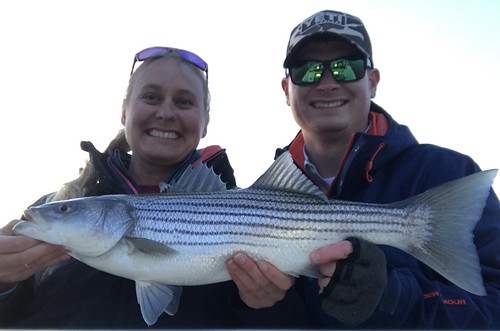
Photo by Kevin Thomas
There is some catch-and-release striped bass action being found out in the bay near structure such as channel edges for those jigging. It can often be slow even when fish can be spotted piled up on the bottom due to cold water temperatures.
The best show in town is of course the warm water discharge at the Calvert Cliffs Power Plant, especially for large striped bass. If you are new to the game it would be wise to stand off and watch how boats position and drift off in the plume then swing around and get inline again. Large soft plastic jigs or butterfly jigs are the ticket to this fun catch-and-release even. Bring stout tackle so you do not excessively wear the fish out and handle quickly and with care.
The lower bay region has also been mostly keyed in on fishing in the tidal rivers for a mix of yellow and white perch. The Nanticoke and Pocomoke rivers have been offering great fishing for post-spawn yellow perch and pre-spawn white perch with a healthy dose of crappie and catfish tossed in. On the western side of the bay the tidal Potomac and its tributaries are getting a lot of attention. The tributaries have excellent opportunities for post-spawn yellow perch and white perch that are holding in deeper waters below the spawning areas.
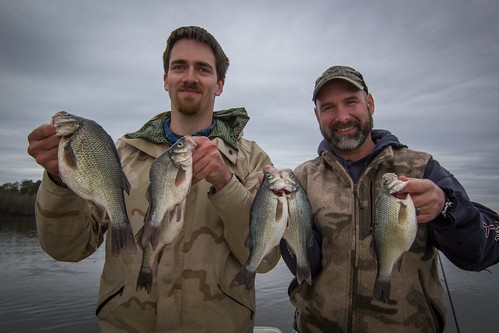
Photo by Jim Thompson
Perhaps one of the most productive fisheries in the lower Potomac River this week is the blue catfish. There certainly are plenty of them and they are relatively easy to catch. Perhaps the biggest key to unlocking this type of fishing is fresh bait – the fresher the better. Fresh-cut white perch is perhaps one of the easiest baits to obtain on-site, but bluegill sunfish from a local pond near where you live will assure you’ll have bait and lessen fishing day bait anxiety. Anywhere along channel edges from the Wilson Bridge south are good places to fish. The medium-sized catfish make for excellent eating; be sure to bring a big ice chest.
Here’s the latest bay and tributaries forecast for tidal waters from the team at Click Before You Cast for the week ending March 26:
The first day of spring continues a pattern of unstable weather for the upcoming week with very windy conditions on through Thursday and rain or snow likely to return Sunday. These cool March conditions will temporarily postpone the warming of Maryland’s bay waters for gamefish preparing to spawn in the next several weeks. The Maryland portion of the bay continues to have suitable oxygen conditions from surface to bottom. In addition, there are slightly warmer surface water temperatures so anglers may want to scan these shallower areas for fish.
Main bay surface water temperatures are holding at 42 degrees at National Oceanic and Atmospheric Administration’s Annapolis and Gooses Reef buoys. However, smaller streams will warm faster and will often hold water temperatures in the upper 40s. Expect reduced water clarity in portions of the larger rivers and upper bay and along windward shorelines. Expect normal to below normal flows for streams and rivers entering Maryland’s portion of the bay. There will be above average tidal currents conditions through Thursday as a result of the new moon March 17.
Check the website for the full weekly fishing conditions summary and more details for your area of the bay. You can now see temperature and oxygen levels by depth — just click on any station on the Temperature by Depth map or the Don’t Fish Below this Depth map. Have a safe and enjoyable fishing trip, and as always, drop us a line with comments or suggestions.
On the freshwater scene, trout closure 2 areas will close March 25 in preparation for the traditional opening day of trout season March 31. Hatchery crews have been working hard to raise enough trout to give put-and-take trout fisherman what is known as preseason trout stockings that started in late December. This has been a fun and exciting time for fishermen to enjoy excellent trout fishing with a little more elbow room. Stocking crews have been placing the trout in our waters with bucket in hand, walking step-by-step over slick muddy banks, or drifting down waterways to spread trout evenly over greater territory.
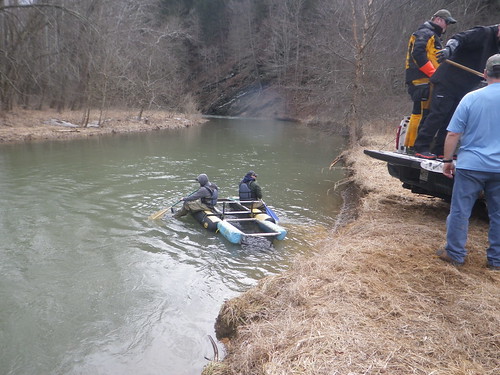
Crews “float stocking” in Maryland Waters. Photo by Alan Klotz
The trout management program in Maryland does its best to provide wonderful trout experiences for all types of anglers; for that reason some areas are catch-and-release only or have tackle restrictions such as fly-fishing only. These areas tend to appeal for those who might be looking for a little more in their trout fishing. In the fly-fishing only areas, fishing with stone fly nymphs, caddis nymphs or perhaps midges would be a good ticket to some cold water action. Most of the trout streams in central and western Maryland are running about 40 degrees, but the smaller streams can warm up a few degrees on a sunny afternoon.
Freshwater fish such as walleye tend to love the cold water temperatures we’re experiencing and one of the best places to fish for them is the upper Potomac River. There has been some wonderful catch-and-release fishing for large pre-spawn walleye taking place this week. Any walleye over 20 inches must be returned to the river; walleye between 15 and 20 inches can be kept with daily limit of five. Various soft plastic jigs tend to be the best bet when fishing for walleyes. Deep Creek Lake also holds a healthy walleye population but currently is closed through April 15 to protect the spawning population.
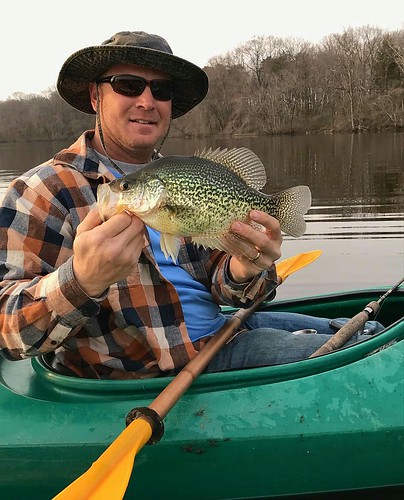
Photo courtesy Jay Yesker
Other popular freshwater species such as largemouth bass and smallmouth bass are waking up from the icy grips of winter and looking for some chow, but crappie and chain pickerel tend to be the first ones to the dinner table. Crappie can be found in tidal and nontidal waters all over the Maryland landscape and right now they tend to be near deep structure such as sunken wood and dams. Small jigs with a lip hooked minnow under a slip bobber is a done deal when fishing for crappie. Chain pickerel seem to be everywhere there is a suitable ambush point for something that looks like food passing by them.
Largemouth bass are slowly coming up from the depths where they spent the winter and often will be found near sunken wood or rocks in transition depths that span the deepest channels leading to the more shallow areas. A variety of jigs, craws and grubs worked slowly near structure will often get a pickup.
At Ocean City, the water temperature is a brisk 41 degrees and weather and wind conditions have not been the most desirable. Tautog fishing at the offshore reef and wreck sites tends to be the only show in town, and that has not too active lately. Captains report that the catches of tautog have been sparse at times, possibly due to cold water conditions.
“There is more B.S. in fly-fishing today than in a Kansas feedlot.” – Lefty Kreh
 ABOUT THE AUTHOR Keith Lockwood has been writing the Fishing Report since 2003 and has had a long career as a fisheries research biologist since 1973. Over the course of his career he has studied estuarine fishery populations, ocean species, and over a decade long study of bioaccumulation of chemicals in aquatic species in New Jersey. Upon moving to Oxford on the eastern shore of Maryland; research endeavors focused on a variety of catch-and-release studies as well as other fisheries related research at the Cooperative Oxford Laboratory. Education and outreach to the fishing public has always been an important component to the mission of these studies. Keith is an avid outdoorsman enjoying hunting, fishing, bird dogs, family and life on the eastern shore of Maryland.
ABOUT THE AUTHOR Keith Lockwood has been writing the Fishing Report since 2003 and has had a long career as a fisheries research biologist since 1973. Over the course of his career he has studied estuarine fishery populations, ocean species, and over a decade long study of bioaccumulation of chemicals in aquatic species in New Jersey. Upon moving to Oxford on the eastern shore of Maryland; research endeavors focused on a variety of catch-and-release studies as well as other fisheries related research at the Cooperative Oxford Laboratory. Education and outreach to the fishing public has always been an important component to the mission of these studies. Keith is an avid outdoorsman enjoying hunting, fishing, bird dogs, family and life on the eastern shore of Maryland.
Sign up for the Weekly Fishing Report to be sent right to your inbox!
